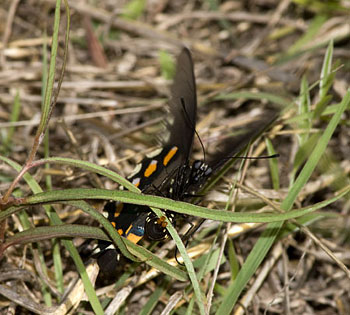Archive for 'Habitat' Category
Caretaker's note: 2008 is a year of extreme to exceptional drought in Central Texas. Supplemental watering helps to keep last years new plantings alive. All new plantings are native species that are selected to be drought tolerant, but it does take a few years for new plants to become established to withstand harsh drought conditions. There were no new plantings this year due to the drought. To conserve water, it is advised to water early in the morning or late in the day.
Posted in
2008 Journal, Census, Habitat, Food, Water
- Fewer hummingbirds and bees seen
- Saw Painted bunting
- Saw a duck on the river
- Saw Great Blue heron
- Ceraunus butterfly
- Southern yellow jackets and red wasps were seen hunting caterpillars
- Many frogs and toad tadpoles
- Saw a skink
- Saw a striped racer lizard with no tail
- Saw 2 juvenile Nine-lined racer lizards
- Saw juvenile anole
- Bobcat seen hunting birds at feeding station
Added large juniper stumps around bird feeding area to provide security for small birds and animals and deter deer.
Posted in
2008 Journal, Census, Habitat, Predator
Swanflower found and saw the Pipevine Swallowtail butterfly laying eggs on it. This is how caretakers were able to identify the Swanflower that is well camouflaged in native grasses.

Caretaker's note: Pipevine Swallowtail butterflies have been found for many years on the land. The Swanflower is the host plant for this species. The Swanflower looks very much like any other grass, but on closer examination has distinct characteristics. It is also known as the Dutchman's Pipevine, because of the unusual flower shape that is similar to a smoking pipe.
Posted in
2008 Journal, Census, Habitat
Very dry, wildflowers are small and sparse. Few insects seen.
Caretaker's note: A Jackrabbit is actually a hare and not a rabbit. It is larger than a rabbit and they typically have taller hind legs and longer ears.
- Removed Johnson grass and Beggars lice weed from the yard
- Removed junipers that are growing up too close underneath the oaks
Posted in
2008 Journal, Census, Habitat, Food
A bee feeding area was set aside to reduce competition with hummingbirds at the hummingbird feeders.
Caretaker's note: Because large numbers of bees completely surround the hummingbird feeders for the sugar water, the hummingbirds avoid those feeders. To deter bees, the bee covered feeders are removed and emptied of the feeding solution. The sugar water was poured into a large pot some distance from the hummingbird feeding area. Once the bees were relocated, the hummingbird feeders were treated with olive oil on the feeding ports to further deter the bees and allow the hummingbirds to feed easily.
- Improved trellis for climbing vines
- Treated fire ants
Planted seeds around the house where it is easy to water.
- 1 pound Shade Friendly Mix
- 1 pound Caliche Mix
- 1 pound All Perennial Mix
- 1 pound Butterfly Retreat Mix
Posted in
2008 Journal, Census, Habitat, Food
<< Previous Entries

